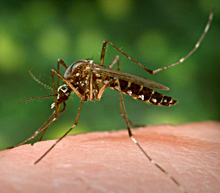How Mosquitoes Detect People
How Mosquitoes Detect People
Researchers discovered a receptor that mosquitoes use to detect both carbon dioxide and skin odor, and they identified compounds that interact with the receptor. The findings may help guide strategies to control mosquitoes and the diseases they transmit.
Mosquitoes have an amazing ability to zero in on us from afar and head straight for our bare skin. Unfortunately, mosquitoes are much more than an itchy annoyance. They transmit several serious diseases including malaria, one of the most common infectious diseases in the world. Nearly 1 million people die of malaria every year. Mosquitoes also transmit Dengue viruses and filarial worms.

Female Aedes aegypti mosquito seeking out a penetrable site on the skin of its host. Photo by James Gathany, courtesy of CDC.
Female mosquitoes have nerve cells called cpA neurons that have a receptor to detect carbon dioxide. This enables them to sense the plumes of air we exhale. But mosquitoes are still attracted to human skin even in the absence of carbon dioxide. A team of researchers led by Dr. Anandasankar Ray at University of California, Riverside, set out to determine the neurons and receptors required for attraction to skin odor. Their research was supported in part by NIH’s National Institute of Allergy and Infectious Diseases (NIAID). Results appeared online on December 5, 2013, in Cell.
Brief exposure to a chemical that shut down the mosquitoes’ carbon dioxide receptor rendered them unable to react to carbon dioxide from exhaled breath. The scientists tested the response of these mosquitoes to skin odorants by placing them in a wind tunnel with a plate of glass beads that had been worn in socks for several hours to give them the scent of human foot odor. Both Aedes aegypti and Anopheles gambiae mosquitoes—which transmitdengue and malaria respectively—were much less attracted to the scented beads after being exposed to the chemical. These results showed that the receptor responsible for detecting carbon dioxide also detects skin odorants.
Chemicals previously known to block mosquitoes’ carbon dioxide receptor can’t be used around people because of unpleasant odors and health safety concerns. To identify more suitable compounds, the team developed a computer simulation method to screen almost half a million chemical compounds in search of structures that might interact with the receptor. They identified 138 compounds that were pleasant smelling, inexpensive, and considered safe for human use.
The researchers focused on 2 of the compounds recognized as safe for humans. Ethyl pyruvate, which has a fruity smell and is approved as a flavor agent in food, blocked attraction of mosquitoes to a human hand. Conversely, cyclopentanone, which is minty-smelling and is approved as a flavor and fragrance agent, attracted mosquitoes to a baited trap as effectively as carbon dioxide.
“Odors that block this dual-receptor for carbon dioxide and skin odor can be used as a way to mask us from mosquitoes. On the other hand, odors that can act as attractants can be used to lure mosquitoes away from us into traps. These potentially affordable ‘mask’ and ‘pull’ strategies could be used in a complementary manner, offering an ideal solution and much needed relief to people in Africa, Asia, and South America—indeed wherever mosquito-borne diseases are endemic,” Ray says.
By Carol Torgan, Ph.D.
###
* The above story is reprinted from materials provided by National Institutes of Health (NIH)
** The National Institutes of Health (NIH) , a part of the U.S. Department of Health and Human Services, is the nation’s medical research agency—making important discoveries that improve health and save lives. The National Institutes of Health is made up of 27 different components called Institutes and Centers. Each has its own specific research agenda. All but three of these components receive their funding directly from Congress, and administrate their own budgets.




















